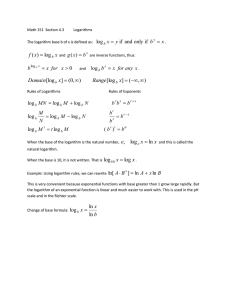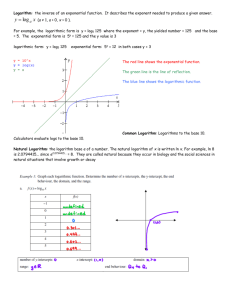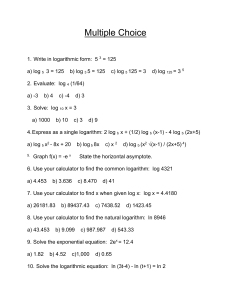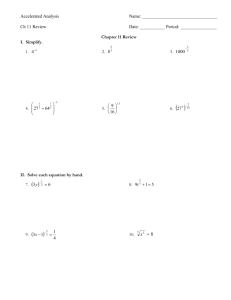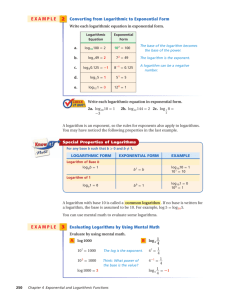( ) Review of Exponential and Logarithmic Functions
advertisement
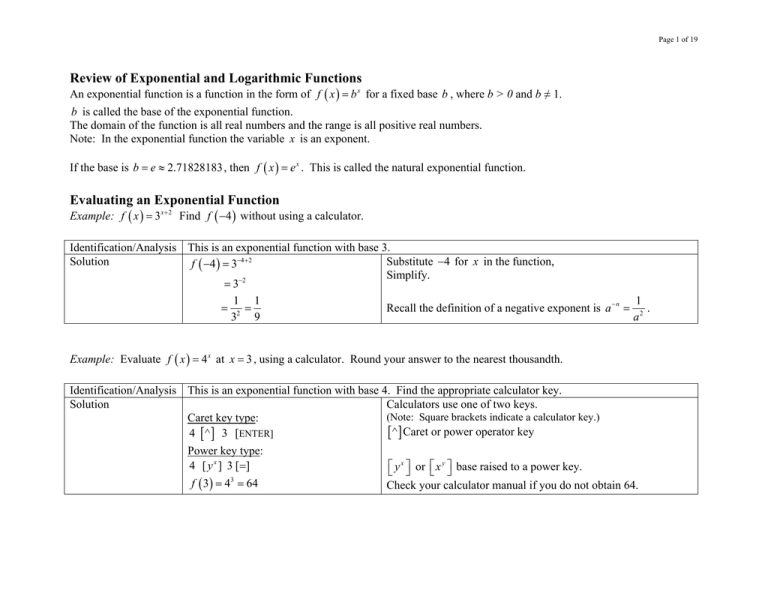
Page 1 of 19
Review of Exponential and Logarithmic Functions
An exponential function is a function in the form of f ( x ) = b x for a fixed base b , where b > 0 and b ≠ 1.
b is called the base of the exponential function.
The domain of the function is all real numbers and the range is all positive real numbers.
Note: In the exponential function the variable x is an exponent.
If the base is b = e ≈ 2.71828183 , then f ( x ) = e x . This is called the natural exponential function.
Evaluating an Exponential Function
Example: f ( x ) = 3x + 2 Find f ( −4 ) without using a calculator.
Identification/Analysis This is an exponential function with base 3.
Solution
Substitute −4 for x in the function,
f ( −4 ) = 3−4+ 2
Simplify.
= 3−2
1 1
1
= 2 =
Recall the definition of a negative exponent is a − n = 2 .
a
3
9
Example: Evaluate f ( x ) = 4 x at x = 3 , using a calculator. Round your answer to the nearest thousandth.
Identification/Analysis This is an exponential function with base 4. Find the appropriate calculator key.
Solution
Calculators use one of two keys.
(Note: Square brackets indicate a calculator key.)
Caret key type:
[ ^ ] Caret or power operator key
4 [ ^ ] 3 [ENTER]
Power key type:
4 [ y x ] 3 [ =]
f ( 3) = 43 = 64
⎡⎣ y x ⎤⎦ or ⎡⎣ x y ⎤⎦ base raised to a power key.
Check your calculator manual if you do not obtain 64.
Page 2 of 19
Example: Evaluate f ( x ) = −e3 x − 4 at x = 2 , using a calculator. Round your answer to the nearest thousandth.
Identification/Analysis This is an exponential function with base e , called the natural exponential function.
3 2 −4
Solution
Substitute 2 for x . Simplify.
f ( 2 ) = −e ( )
= −e 2
For most calculators types:
−[e] 2 [ENTER]
f ( 2 ) = −e 2 ≈ −7.389
Find the e x key on your calculator.
Enter the – sign e followed by 2.
Check your calculator manual if needed to determine the
evaluation sequence.
Logarithms
A logarithm is an exponent.
It is the exponent to which the base must be raised to produce a given number.
For example, since 23 = 8 , then 3 is called the logarithm with base 2 . It is written as: log 2 8 = 3
3 is the exponent to which 2 must be raised to produce 8.
“ 23 = 8 ” is called the exponential form.
“ log 2 8 = 3 ” is called the logarithmic form.
General definition of the logarithm function with base b , b > 0 and b ≠ 1, x > 0 is given by:
log b x = y
is equivalent to
by = x
For example: log 3 9 = 2 is equivalent to 32 = 9
The function is written as f ( x ) = log b x and is read as “log base b of x ” or “logarithm of x with base b .”
Page 3 of 19
The two most often used bases are 10 and e . These are called the common logarithm and natural logarithm.
Common logarithm A common logarithm is a logarithm with a base 10.
When the base is not indicated, such as f ( x ) = log x , a base 10 is implied.
y = log x
Natural logarithm
is equivalent to
10 y = x
A natural logarithm is a logarithm with base e .
It is written as f ( x ) = ln x .
y = ln x
is equivalent to
ey = x
Example: Write log 5 125 = 3 in exponential form.
Identification/Analysis Use the definition of a logarithm to write the logarithm in exponential form.
The base on the logarithm is 5 so the base for exponential form is also 5.
Solution
The logarithm is base 5, so the base of the exponential is also 5.
log 5 125 = 3
3
The logarithm is equal to 3, so the exponent will be 3
5 = 125
Example: Write log 0.01 = −2 in exponential form.
Identification/Analysis Use the definition of a logarithm to write the logarithm in exponential form.
The base on the logarithm is not indicated so base 10 is implied.
Solution
log 0.01 = −2
The logarithm is base 10, so the base of the exponential is 10.
The logarithm is equal to −2 , so the exponent will be −2
−2
10 = 0.01
Page 4 of 19
Example: Write 73 = 343 in logarithmic form.
Identification/Analysis Use the definition of a logarithm to write the exponential as a logarithm.
The base of the exponential is 7, so the base of the logarithm is also 7.
Solution
The exponential is base 7 , so the base of the logarithm is also 7 .
73 = 343
The exponent is 3 , so the logarithm will be equal to 3 .
log 7 343 = 3
Example: Write 10 = x in logarithmic form.
Identification/Analysis Write the radical as an exponent.
Use the definition of a logarithm to write in logarithmic form.
Rewrite the radical as an exponent.
Solution
10 = x
1/ 2
The base of the exponential is 10 so the base of the logarithm is
(10 ) = x
also 10. The base of the common logarithm is also 10.
The exponent is 1/ 2 , so the logarithm will be equal to 1/ 2 .
1
log x =
2
Example: Evaluate log 3 81
Identification/Analysis Use the definition of a logarithm to write the expression in exponential form.
The base on the logarithm is 3, so the base for exponential form is also 3.
Solution
Set the logarithm equal to y .
log 3 81 = y
y
Rewrite the logarithm in exponential form.
3 = 81
The base is 3 and the exponent is y .
y
4
Determine an appropriate exponent.
3 = 81 = 3*3*3*3 = 3
(Factor 81 or write 81 as a power of 3.)
The logarithm is the exponent so the logarithm equals 4
log 3 81 = 4
Page 5 of 19
Example: Evaluate log1000
Identification/Analysis Use the definition of a logarithm to write the expression in exponential form.
The base on the logarithm is not indicated so the base is 10.
log1000 = y
Solution
Set the logarithm equal to y .
y
Rewrite the logarithm in exponential form.
10 = 1000
y
3
Factor1000 or write 1000 as a power of 10 to determine the
10 = 10
exponent.
log1000 = 3
The logarithm is the exponent so the logarithm equals 3.
Example: Evaluate log ( 0.01)
Identification/Analysis Use the definition of a logarithm to write the expression in exponential form.
The base on the logarithm is not indicated so the base is 10.
Solution
log 0.01 = y
Set the logarithm equal to y .
y
Rewrite the logarithm in exponential form.
10 = 0.01
Write 0.01 as a fraction.
1
10 y =
100
Write 100 as a power of 10 to help determine the exponent.
1
10 y = 2 = 10−2
10
log 0.01 = −2
The logarithm is the exponent so the logarithm equals −2 .
Example: Evaluate ln e5
Identification/Analysis This is a natural logarithm with base e . Use the definition of a logarithm to write the expression in
exponential form with base e .
Solution
Set the logarithm equal to y .
ln e5 = y
Rewrite the logarithm in exponential form.
e y = e5
5
The logarithm is the exponent so the logarithm equals 3.
ln e = 5
Page 6 of 19
Properties of Logarithm Functions
The first column lists a property of logarithms. The second column provides a rational for the property based on the definition of a
logarithm. While the third column provides an example of the property.
Property
For b > 0 , b ≠ 1
log b 1 = 0
Rational
Example
b0 = 1
log1 = 0
Since 100 = 1
log b b = 1
b1 = b
log 3 3 = 1
Since 31 = 3
log b b x = x
bx = bx
log 4 43 x = 3x
Since 43 x = 43 x
blogb x = x
b y = x is equivalent to y = log b x
Substitute y = log b x into the first
statement to validate the identity.
eln x = x
If log b x = log b y then x = y
For x > 0 and y > 0 .
The logarithms have the same base
and are equal so the arguments are
equal.
10
log ( 5 x )
= 5x
If log ( x + 7 ) = log ( 2 x )
then
( x + 7) = 2x
Solve for x .
7=x
Example: Evaluate log 3 81
Identification/Analysis This is a logarithm with base 3, so the base of the exponential will also be base 3.
Solution
Write 81 as a power of three since the base on the logarithm is 3.
log 3 81 = log 3 34
log 3 34 = 4
Evaluate the logarithm using log b b x = x .
Page 7 of 19
Example: Evaluate ln e
Identification/Analysis This is the natural logarithm with base e , so the base of the exponential will also be e .
Write the radical in exponential form.
Solution
ln e = ln e1/ 2
Evaluate the logarithm since the base of the logarithm and the
1
ln e1/ 2 =
exponential are both e .
2
Example: Evaluate log 0.0001
Identification/Analysis The base on the logarithm is not indicated so the base is 10.
Solution
Write 0.0001 as a fraction.
1
log 0.0001 = log
10000
Write the fraction as a power of 10 since the base is 10
= log10− 4
log 0.0001 = − 4
Evaluate the logarithm since the bases of both are 10 .
Example: Evaluate: 10
log ( 5 x+ 2 )
Identification/Analysis This is an exponential with base 10. In the exponent is a common logarithm with base 10.
log 5 x + 2
Since the base of the exponential and the base of the logarithm
Solution
10 ( ) = ( 5 x + 2 )
are the same, apply blogb x = x .
Page 8 of 19
Additional Properties of Logarithms
Listed below are properties of logarithms used to expand and condense logarithmic expressions.
The properties apply to any base b but most applications use common ( log x ) or natural logarithms ( ln x ) .
Name of the Property
General Rule Assume
b > 0 , b ≠ 1 , m > 0 and n > 0
Example
Assume x > 0 and y > 0
Stated in Words
Product Rule
log b ( mn ) = log b m + log b n
log ( 3x ) = log 3 + log x
The logarithm of a product equals the
logarithm of the first factor plus the
logarithm of the second factor.
Quotient Rule
log b
m
= log b m − log b n
n
Power Rule
log b mn = n log b m
Change of Base Formula
log b m =
log m
log b
ln m
log b m =
ln b
ln
2
= ln 2 − ln y
y
log x3 = 3log x
or
log 3 5 =
log 5
log 3
The logarithm of a quotient equals the
logarithm of the numerator minus the
logarithm of the denominator.
The logarithm of a power equals the
exponent times the logarithm.
The logarithm base b of m equals the
common logarithm of m divided by the
common logarithm of the original base
b
Note: The quotient can be written with any base
as long as the base in numerator and denominator
are the same.
For the examples below, only common and natural logarithms are used even though the properties apply to any base.
Assume are variables used are positive numbers.
Page 9 of 19
Example: Expand the logarithm ln ( 2x )
Identification/Analysis Expand means to write the logarithm as a sum or difference of simpler logarithms.
This is a natural logarithm of a product.
Solution
Apply the product rule. The log of a product is the sum of the
ln ( 2 x ) = ln 2 + ln x
logs.
⎛ a2 ⎞
Example: Expand. log ⎜ ⎟
⎝ b ⎠
Identification/Analysis Expand means to write the logarithm as a sum or difference of simpler logarithms.
This common logarithm contains a quotient and a power.
Apply the quotient rule. The log of a quotient is the difference of
Solution
⎛ a2 ⎞
log ⎜ ⎟ = log a 2 − log b
the logs.
⎝ b ⎠
= 2 log a − log b
Apply the power rule. The log of an exponential is the exponent
times the log.
⎛ x ⎞
Example: Expand. ln ⎜ ⎟
⎝ 3y ⎠
Identification/Analysis Expand means to write the logarithm as a sum or difference of simpler logarithms.
This natural logarithm contains a quotient and a product.
Solution
Apply the quotient rule. The log of a quotient is the difference of
⎛ x ⎞
ln ⎜ ⎟ = ln x − ln ( 3 y )
the logs.
⎝ 3y ⎠
Apply the product rule. The log of a product is the sum of logs.
= 2 ln x − ( ln 3 + ln y )
Be sure to put the sum in parentheses.
= 2 ln x − ln 3 − ln y
Distribute the negative. (This is not a required step.)
Page 10 of 19
⎛ 100 y ⎞
Example: Expand the logarithm and simplify. log ⎜
⎟
⎝ x ⎠
Identification/Analysis Expand means to write the logarithm as a sum or difference of simpler logarithms.
This is a common logarithm contains a quotient, product and a power.
Apply the quotient rule.
Solution
⎛ 100 y ⎞
log ⎜
⎟ = log (100 y ) − log x
⎝ x ⎠
Apply the product rule.
= log100 + log y − log x
= log102 + log y − log x1/ 2
1
= 2 + log y − log x
2
Write 100 as a power of 10 since the base on the logarithm is 10.
Write the radical as an exponent.
Apply log b b x = x since the bases are both 10.
Apply the power rule.
The following examples use the properties of logarithms in the opposite manner. In other words you start with an expression
containing sums and difference of logarithms and condense to a single logarithm
Example: Condense. Write as a single logarithm. log x + log y − log z
Identification/Analysis Condense means to write as a single logarithm. There is a sum and difference of common logarithms.
In general when there are several terms, apply the rules one at a time moving from left to right.
Solution
Since there is a sum and difference two rules apply.
Apply the product rule in the opposite manner.
log x + log y − log z = log ( xy ) − log z
The sum of logs equals the log of a product.
Apply
the quotient rule. The difference of logs equals the log of
xy
⎛ ⎞
= log ⎜ ⎟
a quotient. The original is written as a single logarithm.
⎝ z ⎠
Page 11 of 19
1
Example: Condense. Write as a single logarithm. 3ln x − ln16
2
Identification/Analysis Condense means to write as a single logarithm.
There is a difference of logarithms and a power times a logarithm.
Apply the power rule.
Solution
1
3ln x − ln16 = ln x3 − ln161/ 2
2
Apply the quotient rule.
⎛ x3 ⎞
= ln ⎜ 1/ 2 ⎟
⎝ 16 ⎠
⎛ x3 ⎞
= ln ⎜ ⎟
⎝ 4⎠
Example: Condense.
Simplify. 161/ 2 = 16
The original is written as a single logarithm.
1
( log x − 3log y + log z )
2
Identification/Analysis Condense means to write as a single logarithm.
There is a sum and difference of logarithms. There are also parenthesis and a power times a logarithm.
Since there is parenthesis, first condense within the parenthesis.
Solution
1
( log x − 3log y + log z )
2
Apply the power rule.
1
= ( log x − log y 3 + log z )
2
In general apply the rules one at a time from left to right.
⎞
1⎛
x
= ⎜ log 3 + log z ⎟
Apply the quotient rule.
2⎝
y
⎠
Apply the product rule.
1⎛
xz ⎞
= ⎜ log 3 ⎟
y ⎠
2⎝
1/ 2
Apply the power rule.
⎛ xz ⎞
xz
= log ⎜ 3 ⎟ or log 3
Leave as an exponent or write as a radical.
y
⎝y ⎠
The original is written as a single logarithm.
Page 12 of 19
Example: Condense 4 log x − log y − 2 log z .
Identification/Analysis Condense means to write as a single logarithm.
There are two differences of logarithms and a logarithm times a power.
Apply the power rule.
Solution
4 log x − log y − 2 log z
= log x 4 − log y − log z 2
= log
x4
− log z 2
y
There are three terms apply the rules from left to right.
Apply the quotient rule.
= log
x4
yz 2
Apply the quotient rule.
The original is written as a single logarithm.
Example: Use a calculator to evaluate log 7 3 . Round to the nearest thousandth.
Identification/Analysis The logarithm is base 7. To evaluate with the calculator it must be written with a base of 10 or e .
Use the change of base formula.
Apply the change of base formula.
Solution
log 3
ln 3
or log 7 3 =
log 7 3 =
Use either the common log or natural log.
log 7
ln 7
log 7 3 =
log 3
≈ 0.565
log 7
Type [ log ] 3 [ ÷] [ log ] 7 [ ENTER ] and round appropriately.
Page 13 of 19
Domain of the logarithmic function
The function f ( x) = log b x,
b > 0, b ≠ 1 has a domain x > 0 Also written { x | x ∈ \, x > 0} or using interval notation ( 0, ∞ )
In words the argument of the logarithm must be positive. The base of the logarithm does not affect the domain.
Example: Find the domain of
f ( x) = log ( x − 7 )
Identification/Analysis The argument of the logarithm has to be positive. The base of the logarithm does not affect the domain.
Solution
The argument of a logarithm must be positive.
( x − 7) > 0
x>7
Solve for x .
State the domain using set builder or interval notation.
{ x | x ∈ \, x > 7} . or ( 7, ∞ )
Example: Find the domain of
f ( x) = ln ( 2 − 3 x )
Identification/Analysis The argument of the logarithm has to be positive. The base of the logarithm does not affect the domain.
Solution
The argument of a logarithm must be positive.
( 2 − 3x ) > 0
−3 x > −2
Solve for x .
Remember when you divide both sides by a negative number the
2
x<
direction of the inequality is reversed.
3
State the domain using set builder or interval notation.
2⎫
2⎞
⎧
⎛
⎨ x | x ∈ \, x < ⎬ or ⎜ − ∞, ⎟
3⎭
3⎠
⎩
⎝
Page 14 of 19
Solving Exponential and Logarithmic Equations
An exponential equation is an equation where the variable is an exponent. In general, consolidate the exponential terms, then isolate
the exponential term containing the variable. Take the logarithm of both sides of the equation. Simplify the logarithm or use the
power rule to write the variable as a factor instead of an exponent.
Example: Solve e x + 4 = 27
Identification/Analysis This is an equation where the variable is an exponent.
The base of the exponential is e so use the natural logarithm.
Solution
Isolate the term containing the variable.
e x + 4 = 27
x
e = 23
Take the natural logarithm of both sides.
ln e x = ln 23
x = ln 23
Simplify the natural logarithm of e to a power
Solve for x .
ln 23
Check/verification
x = ln 23 in the original equation. Simplify.
Substitute
e + 4 = 27
23 + 4 = 27
True, so x = ln 23 is a solution.
Example: Solve 10 x +3 = 15 Solve exactly then use your calculator to estimate the solution to the nearest thousandth.
Identification/Analysis This is an equation where the variable is an exponent.
The base of the exponential is 10 so use common logarithms.
Solution
The term with the variable is isolated.
10 x+3 = 15
x+ 3
Take the common logarithm of both sides.
log10 = log15
x + 3 = log15
Simplify the common logarithm of 10 to a power.
x = log15 − 3 ≈ −1.824
Solve exactly for x . Approximate with your calculator.
log15
−
3
+
3
)
Check/verification
Substitute x = log15 − 3 into the original equation.
10(
= 15
Simplify the right side. Combine −3 + 3 .
10log15 = 15
The base of the exponential and the logarithm are the same.
15 = 15
True, so x = log15 − 3 is a solution.
Page 15 of 19
Example: Solve 32 x +1 = 27
Identification/Analysis This is an equation where the variable is an exponent. There are two distinct bases, 3 and 27.
Both bases can be written using base 3.
Solution
Both exponentials can be written using base 3.
32 x +1 = 27
2 x +1
3
Write each exponential with base 3.
3
=3
2x +1 = 3
Since the bases are equal the exponents are equal.
2x = 2
Solve for x .
x =1
2
1
+
1
(
)
Check/verification
Substitute x = 1 into the original equation.
3
= 27
3
Simplify. True so, x = 1 is a solution.
3 = 27
Example: Solve 3x = 2 x +1 Find the exact
Identification/Analysis This is an equation where the variable is an exponent. There are two distinct bases, 3 and 2.
The bases do not have a common factor so we cannot write them using the same base
Solution
The bases are distinct and cannot be written using the same base.
3x = 2 x +1
( x +1)
x
Take the log of both sides. Use either common or natural log.
log 3 = log 2
x log 3 = ( x + 1) log 2
x log 3 = x log 2 + log 2
x log 3 − x log 2 = log 2
x ( log 3 − log 2 ) = log 2
log 2
log 3 − log 2
log 2
≈ 1.710
x=
log 3 − log 2
x=
Check/verification
31.7095 = 21.7095+1
6.54092 ≈ 6.54095
so x ≈ 1.710
Apply the power rule. Solve for x .
Distribute log 2 .
Collect the variable x on one side of the equation.
Factor out the variable x .
Divide both sides by ( log 3 − log 2 ) , the coefficient of x .
Approximate with a calculator. Round to thousandths.
Substitute the approximated value for x in the original equation.
Evaluate with a calculator. The two sides are ≈ .
Page 16 of 19
Logarithmic Equations
A logarithmic equation is an equation that has a logarithmic expression containing a variable.
Example: Solve log( x − 5) + 6 = 8
Identification/Analysis This is a logarithmic equation with a common logarithm. There is one logarithmic term.
Solution
log( x − 5) + 6 = 8
There is a logarithmic term which contains a variable.
Isolate the logarithmic term.
log ( x − 5 ) = 2
102 = ( x − 5 )
Check/verification
102 + 5 = x
x = 105
log (105 − 5 ) + 6 = 8
log100 + 6 = 8
2+6 =8
8=8
Use the definition of a logarithm to write in exponential form.
Solve for x .
Simplify.
Substitute x = 105 in the original equation.
Simplify each side independently.
Use 100 = 102 to simplify the common logarithm.
True so x = 105 is a solution.
Example: Solve 3 + ln ( x − 2 ) = 5 Solve exactly then use your calculator to estimate the solution to the nearest thousandth.
Identification/Analysis This is a logarithmic equation with a natural logarithm. There is one logarithmic term.
Solution
There is a logarithmic term which contains a variable.
3 + ln ( x − 2 ) = 5
ln ( x − 2 ) = 2
e2 = ( x − 2 )
Check/verification
x = e 2 + 2 ≈ 9.389
3 + ln ( 9.389 − 2 ) = 5
4.999992 ≈ 5
Isolate the logarithmic term.
Use the definition of a logarithm to write in exponential form.
Solve for x . Approximate with a calculator.
Substitute x = 9.389 in the original equation.
Simplify the left side using a calculator.
The two sides are approximately equal.
Page 17 of 19
Example: Solve log x − log 4 = 2
Identification/Analysis This is a logarithmic equation with a common logarithm.
There are two logarithmic terms and a term without a logarithm.
Use properties of logarithms to condense to a single logarithmic term.
log x − log 4 = 2
Solution
There are two logarithmic terms.
Apply the quotient rule.
x
log = 2
4
Use the definition of a logarithm to write in exponential form.
x
102 =
4
Solve for x and simplify.
x = 4*102 = 400
Check/Verification
log 400 − log 4 = 2
2=2
Substitute x = 400 in the original equation.
Evaluate the left side using a calculator.
True so x = 400 is a solution.
Example: Solve ln ( 3 x + 1) = ln 7
Identification/Analysis This is a logarithmic equation with a natural logarithm.
There are two logarithmic terms and no terms without a logarithm.
Solution
There is a single logarithm on each side of the equation.
ln ( 3 x + 1) = ln 7
( 3x + 1) = 7
3x = 6
x=2
Check/Verification
ln ( 3* 2 + 1) = ln 7
ln 7 = ln 7
The logarithms are equal so the arguments are equal.
Solve for x .
Substitute x = 2 in the original equation.
Simplify. True so x = 2 .
Page 18 of 19
Example: Solve log ( x + 21) + log x = 2 Solve exactly then use a calculator to approximate the solution to the nearest thousandth.
Identification/Analysis This is a logarithmic equation with a common logarithm.
There are two logarithmic terms. Use properties of logarithms to condense to a single logarithmic term.
Solution
There are two logarithmic terms.
log ( x + 21) + log x = 2
log ⎡⎣( x + 21)( x ) ⎤⎦ = 2
102 = ⎡⎣( x + 21)( x ) ⎤⎦
100 = x 2 + 21x
x 2 − 21x − 100 = 0
( x + 25)( x − 4 ) = 0
Check/Verification
x = −25 or x = 4
log ( −25 + 21) + log − 25 = 2
log ( 2 + 21) + log 4 = 2
2=2
Apply the product rule.
Use the definition of a logarithm to write in exponential form.
Solve for x .
Second degree equation
Factor or use the quadratic equation.
Substitute x = −25 in the original equation.
Notice this requires taking the logarithm of a negative number.
The domain of the logarithm requires the argument to be positive
so x = −25 is not a solution to the equation.
Substitute x = 4 in the original equation.
Evaluate the left side using a calculator.
True so x = 4 is a solution.
Page 19 of 19
Example: Solve log ( x + 3) = log ( x − 1) + log 3
Identification/Analysis This is a logarithmic equation with a common logarithm.
There are two logarithmic terms and no terms without a logarithm
Solution
There are three logarithmic terms. Condense each side.
log ( x + 3) = log ( x − 1) + log 3
log ( x + 3) = log ⎡⎣( x − 1) *3⎤⎦
( x + 3) = ( x − 1) *3
x + 3 = 3x − 3
Apply the product rule.
The logarithms are equal so the arguments are equal.
Solve for x .
6 = 2x
x=3
Check/Verification
log ( 3 + 3) = log ( 3 − 1) + log 3
log ( 6 ) = log ( 2 ) + log 3
Substitute x = 2 in the original equation.
Simplify.
log 6 = log ( 2*3)
Apply the product rule to the right side.
0.778 = 0.301 + 0.477
Or approximate each side using a calculator.
In either case the statement is true so x = 3 is a solution.
